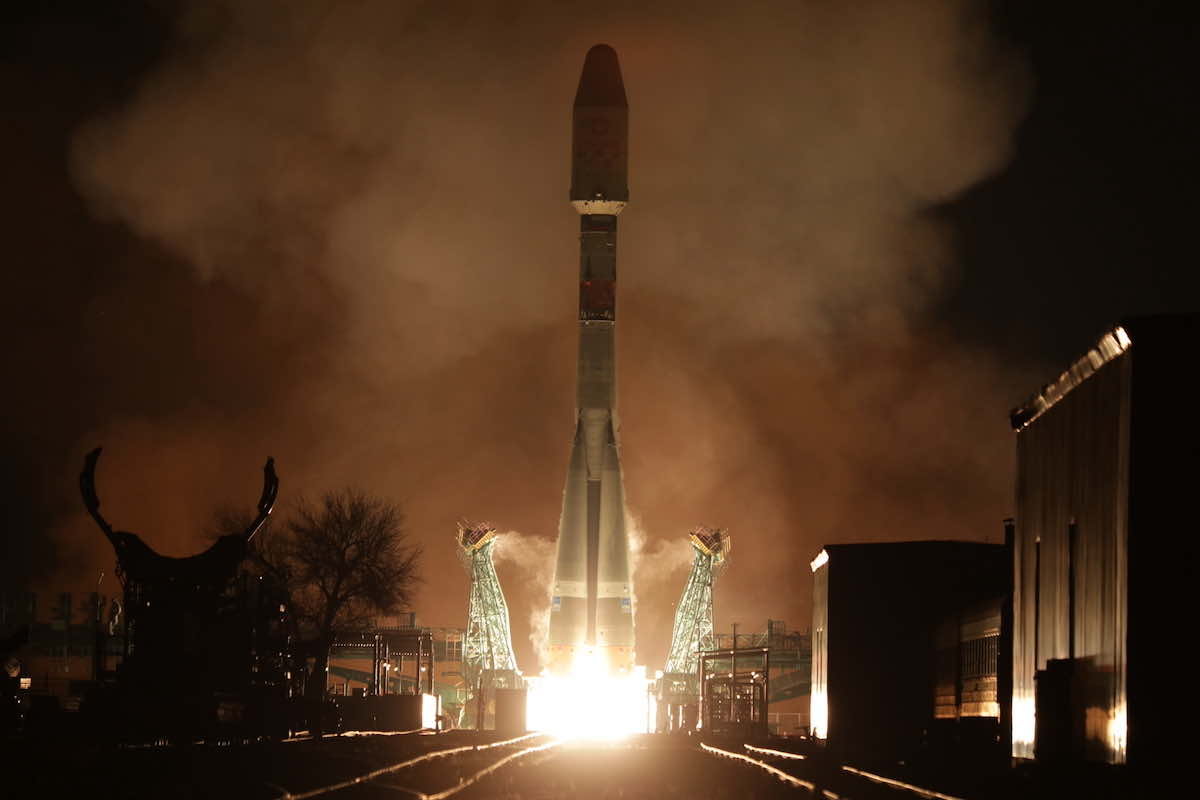Space News & Blog Articles
OneWeb adds 36 more satellites to internet network
 A Soyuz-2.1b rocket lifts off Dec. 27 with 36 OneWeb satellites. Credit: Roscosmos
A Soyuz-2.1b rocket lifts off Dec. 27 with 36 OneWeb satellites. Credit: Roscosmos
A Russian Soyuz rocket launched Monday with 36 more OneWeb internet satellites, the 12th of 19 Soyuz missions needed to deliver into orbit the company’s first-generation network of nearly 650 spacecraft.
The mission took off from the Baikonur Cosmodrome in Kazakhstan at 8:10:37 a.m. EST (1310:37 GMT), or 6:10 p.m. local time at the historic cosmodrome in Central Asia, about one hour after sunset.
Thirty-six OneWeb satellites, built in Florida, were mounted top of the rocket as it fired away from Baikonur with nearly a million pounds of thrust. Arcing to the north from Baikonur, the 15-story launcher jettisoned its four kerosene-fueled boosters about two minutes after liftoff, then released its core stage and payload fairing.
A third stage engine finished the Soyuz rocket’s role in the mission less than 10 minutes into the flight, giving way to a Fregat upper stage for a pair of orbit insertion burns to reach a polar orbit around 279 miles (450 kilometers) high.
The satellites separated from the dispenser in groups of four, beginning about 1 hour, and 18 minutes, after launch. The final four satellites deployed nearly four hours into the mission.
The satellites were expected to unfurl solar panels and use their ion thrusters to reach an operational orbit at 745 (1,200 kilometers) miles above Earth.
“Today’s launch is a great way for OneWeb to complete a highly successful year,” said Neil Masterson, CEO of London-based OneWeb. “With more than sixty percent of our constellation now in space, the business is fully-funded and we have a growing workforce of more than 400 people. I have been immensely proud to lead the business and our team over the last year as we continue to make substantial progress launching our global network, and I look forward to building on this momentum in 2022.”
OneWeb’s satellites are built in a factory just outside the gates of NASA’s Kennedy Space Center in Florida by a joint venture between OneWeb and Airbus Defense and Space.
The company’s network is one of two large mega-constellations well advanced into deployment and initial operations. SpaceX’s Starlink internet fleet is the other one.
SpaceX has launched 1,944 satellites for the Starlink network to date using the company’s reusable Falcon 9 rocket fleet. SpaceX’s Starlink satellites fly closer to Earth than OneWeb’s spacecraft — at an altitude of around 340 miles (550 kilometers) — reducing risks that failed satellites will create a long-term space junk problem. But the lower altitude means the Starlink network needs more spacecraft than OneWeb to connect the globe.
Arianespace won a contract in 2015 to launch OneWeb’s first-generation network. After several changes to the contract, the deal between Arianespace and OneWeb now covers 19 launches aboard Russian Soyuz rockets from spaceports in Russia, Kazakhstan, and French Guiana.
Monday’s launch was the 12th Soyuz launch with OneWeb satellites since the first batch rocketed into orbit in February 2019. OneWeb is planning another generation of spacecraft to handle more internet traffic, and that constellation could number thousands of satellites.
OneWeb has launched 394 satellites, with the new craft shot into orbit Monday. The company plans to deploy 648 satellites in its first-generation constellation, enough to provide low-latency internet service worldwide.
The satellites each weigh about 325 pounds (147.5 kilograms) at launch, with xenon fuel for the ion thrusters used in orbital maneuvers. For launch, the spacecraft are positioned on a custom-built dispenser structure inside the Soyuz rocket’s payload shroud.
OneWeb and Arianespace plan to complete launches of the first-generation fleet in 2022, with seven Soyuz flights scheduled from Baikonur and French Guiana. The next OneWeb launch, set for February, will originate from the French Guiana spaceport.
This email address is being protected from spambots. You need JavaScript enabled to view it. the author.
Follow Stephen Clark on Twitter: @StephenClark1.
When you subscribe to the SpaceZE News Feed, we will send you an e-mail when there are new updates on the site so you wouldn't miss them.

